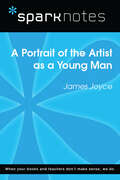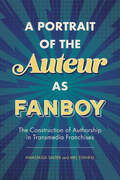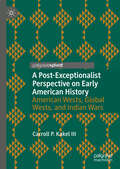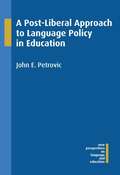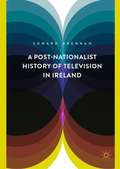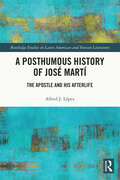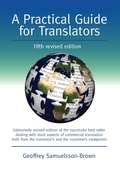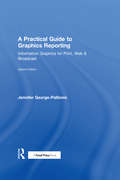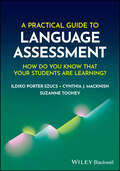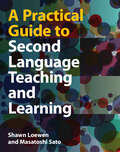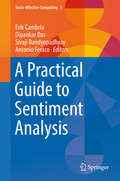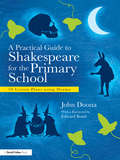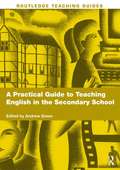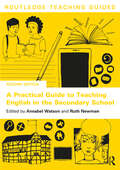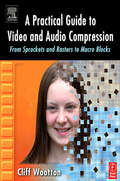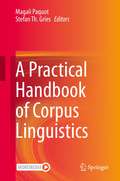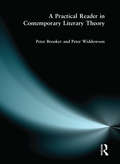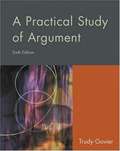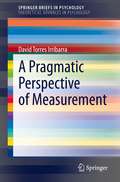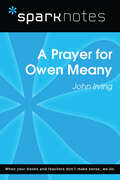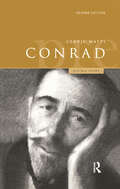- Table View
- List View
A Portrait of the Artist as a Young Man (SparkNotes Literature Guide Series)
by SparkNotesA Portrait of the Artist as a Young Man (SparkNotes Literature Guide) by James Joyce Making the reading experience fun! Created by Harvard students for students everywhere, SparkNotes is a new breed of study guide: smarter, better, faster. Geared to what today's students need to know, SparkNotes provides: *Chapter-by-chapter analysis *Explanations of key themes, motifs, and symbols *A review quiz and essay topicsLively and accessible, these guides are perfect for late-night studying and writing papers
A Portrait of the Auteur as Fanboy: The Construction of Authorship in Transmedia Franchises
by Anastasia Salter Mel StanfillIncreasingly over the past decade, fan credentials on the part of writers, directors, and producers have come to be seen as a guarantee of quality media making—the “fanboy auteur.” Figures like Joss Whedon are both one of “us” and one of “them.” This is a strategy of marketing and branding—it is a claim from the auteur himself or industry PR machines that the presence of an auteur who is also a fan means the product is worth consuming. Such claims that fan credentials guarantee quality are often contested, with fans and critics alike rejecting various auteur figures as the true leader of their respective franchises. That split, between assertions of fan and auteur status and acceptance (or not) of that status, is key to unravelling the fan auteur.In A Portrait of the Auteur as Fanboy: The Construction of Authorship in Transmedia Franchises, authors Anastasia Salter and Mel Stanfill examine this phenomenon through a series of case studies featuring fanboys. The volume discusses both popular fanboys, such as J. J. Abrams, Kevin Smith, and Joss Whedon, as well as fangirls like J. K. Rowling, E L James, and Patty Jenkins, and dissects how the fanboy-fangirl auteur dichotomy is constructed and defended by popular media and fans in online spaces, and how this discourse has played in maintaining the exclusionary status quo of geek culture. This book is particularly timely given current discourse, including such incidents as the controversy surrounding Joss Whedon’s so-called feminism, the publication of Harry Potter and the Cursed Child, and contestation over authorial voices in the DC cinematic universe, as well as broader conversations about toxic masculinity and sexual harassment in Hollywood.
A Post-Exceptionalist Perspective on Early American History: American Wests, Global Wests, and Indian Wars
by Carroll P. Kakel IIIThis book argues that early American history is best understood as the story of a settler-colonial supplanting society—a society intent on a vast land grab of American Indian space and driven by a logic of elimination and a genocidal imperative to rid the new white settler living space of its existing Indigenous inhabitants. Challenging the still strongly held notion of American history as somehow exceptional or unique, it locates the history of the United States and its colonial antecedents as a central part of—rather than an exception to—the emerging global histories of imperialism, colonialism, and genocide. It also explores early American history in an imperial, transnational, and global frame, showing how the precedent of the North American West and its colonial trope of Indian wars were used by like-minded American and European expansionists to inspire and legitimate other imperial-colonial adventures from the late-nineteenth through the mid-twentieth centuries.
A Post-Liberal Approach to Language Policy in Education
by John E. PetrovicThis provocative defense of language diversity works through the strengths and weaknesses of liberal political theory to inform language policy. The book presents the argument that policy must occupy the space between 'linguistics of community' and 'linguistics of contact' in a way that balances individual autonomy and group recognition while not reifying 'language'. Drawing on the importance of the language/identity link, the author distinguishes between language negative liberalism and language positive liberalism, arguing against the former. This distinction orients consideration of increasingly specific language policy issues, such as official languages, language rights, bilingual education, and uses of language varieties within classrooms.
A Post-Nationalist History of Television in Ireland
by Edward BrennanThis book explores the question of how society has changed with the introduction of private screens. Taking the history of television in Ireland as a case study due to its position at the intersection of British and American media influences, this work argues that, internationally, the transnational nature of television has been obscured by a reliance on institutional historical sources. This has, in turn, muted the diversity of audience experiences in terms of class, gender and geography. By shifting the focus away from the default national lens and instead turning to audience memories as a key source, A Post-Nationalist History of Television in Ireland defies the notion of a homogenous national television experience and embraces the diverse and transnational nature of watching television. Turning to people’s memories of past media, this study ultimately suggests that the arrival of the television in Ireland, and elsewhere, was part of a long-term, incremental change where the domestic and the intimate became increasingly fused with the global.
A Posthumous History of José Martí: The Apostle and his Afterlife (Routledge Studies in Latin American and Iberian Literature)
by Alfred J. LópezA Posthumous History of José Martí: The Apostle and His Afterlife focuses on Martí’s posthumous legacy and his lasting influence on succeeding generations of Cubans on the island and abroad. Over 120 years after his death on a Cuban battlefield in 1895, Martí studies have long been the contested property of opposing sides in an ongoing ideological battle. Both the Cuban nation-state, which claims Martí as a crucial inspiration for its Marxist revolutionary government, and diasporic communities in the US who honor Martí as a figure of hope for the Cuban nation-in-exile, insist on the centrality of his words and image for their respective visions of Cuban nationhood. The book also explores more recent scholarship that has reassessed Martí’s literary, cultural, and ideological value, allowing us to read him beyond the Havana-Miami axis toward engagement with a broader historical and geographical tableau. Martí has thus begun to outgrow his mutually-reinforcing cults in Cuba and the diaspora, to assume his true significance as a hemispheric and global writer and thinker.
A Practical Guide for Translators
by Geoffrey Samuelsson-BrownThis is the fifth revised edition of the best-selling A Practical Guide for Translators. It looks at the profession of translator on the basis of developments over the last few years and encourages both practitioners and buyers of translation services to view translation as a highly-qualified, skilled profession and not just a cost-led word mill. The book is intended principally for those who have little or no practical experience of translation in a commercial environment. It offers comprehensive advice on all aspects relevant to the would-be translator and, whilst intended mainly for those who wish to go freelance, it is also relevant to the staff translator as a guide to organisation of work and time. Advice is given on how to set up as a translator, from the purchase of equipment to the acquisition of clients. The process of translation is discussed from initial enquiry to delivery of the finished product. Hints are given on how to assess requirements, how to charge for work, how to research and use source material, and how to present the finished product. Guidance is given on where to obtain further advice and professional contacts. This revised edition updates practices in the translation profession and considers the impact of web-based translation offerings. Industry and commerce rely heavily on the skills of the human translator and his ability to make intellectual decisions that is, as yet, beyond the capacity of computer-aided translation.
A Practical Guide to Graphics Reporting: Information Graphics for Print, Web & Broadcast
by Jennifer George-PalilonisSince this book first published in 2006, the field of information visualization has changed dramatically. First, information visualization has exploded online and on other digital platforms. Second, information graphics reporting has encompassed nearly every sector of communication and business. Visual reporting skills are not only relevant in traditional news environments, but many other professions as well. This edition seeks to address these changes by providing learners with a cross-platform, cross-industry approach to instruction. It will include a robust, dynamic website complete with regularly updated examples of print, online, and broadcast graphics, as well as useful tutorials and exercises. This book covers everything you need to know about reporting with graphics; information visualization and graphic design from a journalistic perspective. A companion website includes regularly updated examples of print, online, and broadcast graphics, as well as tutorials and exercises. Chapters include relevant case studies and conclude with essays from experts. When appropriate, resource files for exercises (such as Illustrator templates, images, and/or other visual reference material) will also be provided on the companion website. thegraphicsreporter.com
A Practical Guide to Language Assessment: How Do You Know That Your Students Are Learning?
by Ildiko Porter-Szucs Cynthia J. Macknish Suzanne TooheyAn essential resource on effective language assessment, invaluable for a new generation of teachers and education researchers A Practical Guide to Language Assessment helps educators at every level redefine their approach to language assessment. Grounded in extensive research and aligned with the latest advances in language education, this comprehensive guide introduces foundational concepts and explores key principles in test development and item writing. Authored by a team of experienced language teacher educators, this book addresses the potential impacts of poorly designed tools and prepares teachers to make informed, effective assessment decisions. Perfect for developing test blueprints and crafting effective assessment tools, including those for young learners, A Practical Guide to Language Assessment bridges the gap between theory and practice to provide the real-world training educators need to successfully navigate the complexities of modern language assessment. Clear and accessible chapters highlight the critical role of well-designed assessments, emphasize the importance of selecting appropriate tools to accurately measure student proficiency, and discuss recent innovations and emerging needs. With practical examples and a focus on current innovations, including ‘ungrading’ and the use of AI, A Practical Guide to Language Assessment: Explains the foundational concepts of language assessment with practical examples and clear explanations Bridges theoretical principles with practical applications, enabling educators to create effective test blueprints and assessment items and tasks Provides up-to-date coverage of timely topics such as the integration of AI in assessments and the ethical and legal considerations of language testing Features a wealth of in-depth examples of how theoretical concepts can be operationalized in practice A Practical Guide to Language Assessment is an essential read for students in language education, as well as teachers, assessment managers, professional development trainers, and policymakers in language program evaluation.
A Practical Guide to Scientific Writing in Chemistry: Scientific Papers, Research Grants and Book Proposals
by Andrew Terhemen TyowuaSuccessful completion of postgraduate studies, especially PhD, and career advancement in academia strongly depend on the ability to publish scientific papers or books and attract research grants. However, many chemical scientists find preparing scientific papers and research grant and book proposals difficult; partly because of insufficient training in writing and partly because there are few practical books to enable them to learn the art. This step-by-step practical guide is intended mainly for postgraduate students and early career researchers in chemical science and the libraries that serve them but will also be useful to other scientists. Key Features: Improves the reader’s chances of getting their manuscript published in chemistry journals. Increases the likelihood of winning research grants in chemistry. Takes a “lead by the hand” approach. Contains chapters on the preparation of graphical abstracts and research highlights. Uses sketches and other illustration styles to aid mental visualization of concepts. Contains practical examples taken from published papers and successful research grant proposals.
A Practical Guide to Second Language Teaching and Learning
by Shawn Loewen Masatoshi SatoAn essential resource for individuals entering the field of second language (L2) teaching and learning, this book provides a complete set of instructional materials written in accessible language. Providing enough material to use for an entire semester, the book offers exciting activities for the L2 classroom, alongside outlining the theories and research that support them, including how to connect theory with practice. Each chapter includes: extensive and up-to-date content presented in a clear, engaging, and accessible manner; pre- and post-reading activities to help students connect the topics to their own lives; pedagogical guidelines with practical suggestions; summaries of empirical studies in non-technical, jargon-free language; end-of-chapter assignments which re-enforce students' learning and relate directly to the content. The book concludes with a compelling chapter on the research–practice dialogue. Online resources include lecture slides for instructors and audio files.
A Practical Guide to Sentiment Analysis (Socio-Affective Computing #5)
by Erik Cambria Dipankar Das Sivaji Bandyopadhyay Antonio FeracoSentiment analysis research has been started long back and recently it is one of the demanding research topics. Research activities on Sentiment Analysis in natural language texts and other media are gaining ground with full swing. But, till date, no concise set of factors has been yet defined that really affects how writers' sentiment i. e. , broadly human sentiment is expressed, perceived, recognized, processed, and interpreted in natural languages. The existing reported solutions or the available systems are still far from perfect or fail to meet the satisfaction level of the end users. The reasons may be that there are dozens of conceptual rules that govern sentiment and even there are possibly unlimited clues that can convey these concepts from realization to practical implementation. Therefore, the main aim of this book is to provide a feasible research platform to our ambitious researchers towards developing the practical solutions that will be indeed beneficial for our society, business and future researches as well.
A Practical Guide to Shakespeare for the Primary School: 50 Lesson Plans using Drama
by John DoonaShakespeare is one of our key historical figures but so often he remains locked behind glass and hard to reach. The purpose of this book is to unlock Shakespeare, to remove the tag of ‘high art’ that has surrounded his work and return him to the heart of popular culture where his plays began in the first place. In his foreword, playwright Edward Bond says of A Practical Guide to Shakespeare for the Primary School, ‘It is written with knowledge and experience of its subject – but also with the knowledge of the young people with whom that experience was shared‘. John Doona will inspire and motivate pupils and teachers alike to engage with Shakespeare in a fresh and accessible manner and provide clear, tried and tested schemes of work which demonstrate how engagement with the plays and their language can have a dramatic impact on children’s literacy and writing. As well as providing practical guidance to classroom delivery and performance, techniques, approaches and attitudes, this handbook also promotes learning outcomes linked to literacy targets and cross-curricular units of learning. The central chapters of the book form a comprehensive cross-curricular unit of work on four specific plays – The Tempest, Macbeth, A Midsummer Night’s Dream and Romeo and Juliet – providing background notes and historical facts linked to the plays, along with comprehensive schemes of work for immediate implementation and ideas for generating performance. Features unique to this resource include:- Free electronic ‘info-blasts’ to all book buyers containing electronic versions of key elements of the book as well as additional resources and lesson plans Drama for the Petrified - A crash course for teachers in the techniques, approaches and attitudes required to bring Shakespeare to life A chapter on Shakespeare and his life, including ‘Five minute Will’ a short comic scripted account of his life Comprehensive schemes of work, each including a Teachers’ Crib Sheet, Story Whoosh!, Story Jigsaw, Scheme Structure Map, edited scenes and additional classroom resources A Practical Guide to Shakespeare for the Primary School is an essential resource for all primary teachers, trainee teachers and drama practitioners, offering guidance, insight and compelling schemes of work for the study of Shakespeare through drama in the primary classroom.
A Practical Guide to Teaching English in the Secondary School
by Andrew GreenA Practical Guide to Teaching English in the Secondary School offers straightforward advice, inspiration and support for all training and newly qualified secondary English teachers. Based on the best research and practice available, it offers a wide range of tried and tested strategies and practical activities to ensure success in the secondary classroom. Illustrated throughout with examples of good practice and activities to promote careful thought, the Practical Guide covers key aspects of English teaching, including: Effective lesson planning and pupil progress Getting started with drama Teaching poetry successfully and enjoyably Media education and media studies - an introduction to the curriculum and designing schemes of work Teaching English Language Choosing and using fiction for all ages English Literature at A Level Opportunities for ICT in English Planning meaningful assessment. A Practical Guide to Teaching English in the Secondary School is an essential companion to the best selling Learning to Teach English in the Secondary School. Written by expert professionals, it provides detailed examples of theory in practice, enabling you to analyse and reflect on your own teaching in order to ensure pupil learning is maximised. Providing a combination of practical ideas, educational rationales and activities to stimulate personal thought and development, this book explores a wide range of issues pertinent to the teaching and learning of English in the 21st century.
A Practical Guide to Teaching English in the Secondary School (Routledge Teaching Guides)
by Annabel WatsonA Practical Guide to Teaching English in the Secondary School offers straightforward advice, inspiration and a wide range of tried and tested approaches to help you find success in the secondary English classroom. Covering all aspects of English teaching, it is designed for you to dip in and out of, and enable you to focus on specific areas of teaching, your programme or pupils’ learning. Fully updated to reflect what student and early career teachers see and experience when they enter the classroom, the second edition supports trainee and practicing teachers to teach in imaginative and creative ways to promote learning in English. Packed with ideas, resources, practical teaching activities and underpinned by the latest research into how children learn, the book examines the core areas of reading, writing and spoken English including: • Plays, poetry, non-fiction, myths and legends, drama and Shakespeare • Developing writing • Creative grammar • Talk and classroom dialogue • Media and digital writing • English across the curriculum • Well-being through writing • Literature and language post-16. Including tools to support critical reflection, A Practical Guide to Teaching English in the Secondary School is an essential companion for all training and newly qualified English teachers.
A Practical Guide to Therapeutic Communication for Health Professionals
by Julie Hosley Elizabeth Molle-MatthewsThis new textbook is designed to provide students with all the necessary tools to effectively communicate with patients and other health care professionals. With its easy-to-read style, it is loaded with useful tips to help students engage into the practice of communication. <p><p>It presents condensed amounts of content for learning the basic principles and then integrating elements such as case scenarios, questions, or hints and tips to encourage application of those principles into real-life situations.
A Practical Guide to Video and Audio Compression: From Sprockets and Rasters to Macro Blocks
by Cliff WoottonLearn all about Codecs--how they work, as well as design and implementation with this comprehensive, easy-to-use guide to compression. After reading this book, you will be able to prepare and distribute professional audio and video on any platform including streamed to the web, broadcast on-air, stored in PVRs, Burned onto CD-ROMs or DVDs, delivered by broadband, or viewed in Kiosk applications, PDA devices, and mobile phones.
A Practical Handbook of Corpus Linguistics
by Stefan Th. Gries Magali PaquotThis handbook is a comprehensive practical resource on corpus linguistics. It features a range of basic and advanced approaches, methods and techniques in corpus linguistics, from corpus compilation principles to quantitative data analyses. The Handbook is organized in six Parts. Parts I to III feature chapters that discuss key issues and the know-how related to various topics around corpus design, methods and corpus types. Parts IV-V aim to offer a user-friendly introduction to the quantitative analysis of corpus data: for each statistical technique discussed, chapters provide a practical guide with R and come with supplementary online material. Part VI focuses on how to write a corpus linguistic paper and how to meta-analyze corpus linguistic research. The volume can serve as a course book as well as for individual study. It will be an essential reading for students of corpus linguistics as well as experienced researchers who want to expand their knowledge of the field.
A Practical Reader in Contemporary Literary Theory
by Peter Brooker Peter WiddowsonThis introduction to practicing literary theory is a reader consisting of extracts from critical analyses, largely by 20th century Anglo-American literary critics, set around major literary texts that undergraduate students are known to be familiar with. It is specifically targeted to present literary criticism through practical examples of essays by literary theorists themselves, on texts both within and outside the literary canon. Four example essays are included for each author/text presented.
A Practical Study of Argument (6th edition)
by Trudy GovierGovier, a Canadian philosopher and lecturer, explains the uses of good arguments, and provides the theoretical base for determining which arguments are good, and which are bad. She describes inductively strong and deductively valid arguments, as well as analogies and fallacies, supported with numerous examples and exercises. The sixth edition expands the discussion of internet sources, explores the significance of the failure to find WMDs in Iraq, and provides five new essays for analysis in the appendix.
A Pragmatic Perspective of Measurement (SpringerBriefs in Psychology)
by David Torres IrribarraThis book aims to address the challenges of defining measurement in social sciences, presenting a conceptualization of the practice of measurement from the perspective of the pragmatic tradition in philosophy. The book reviews key questions regarding the scope and limits of measurement, emphasizing that if the trust that the public places on measures in the social sciences relies on their connection to the notion of measurement in the physical sciences, then the clarification of the similarities and differences between measurement in the physical and the social realms is of central importance to adequately contextualize their relative advantages and limitations. It goes on to present some of the most influential theories of measurement such as the “classical view” of measurement, operationalism, and the representational theory of measurement, as well as more methodological perspectives arising from the practice of researchers in the social sciences, such as the latent variable perspective, and from the physical sciences and engineering, represented by metrology. This overview illustrates that the concept of measurement, and that of quantitative methods, is currently being used across the board in ways that do not necessarily conform to traditional, classical definitions of measurement, pushing the boundaries of what constitutes our technical understanding of it. Moreover, what constitutes a technical understanding of measurement, and the theoretical commitments that it entails, must vary in different areas. In this context, disagreement on what is constitutive of measurement is bound to appear. Pragmatism is presented as a theoretical perspective that offers the advantage of being flexible and fallibilist, encouraging us to abandon the pursuit of a timeless and perfect definition that attempts to establish decontextualized/definitive demarcation criteria for what is truly measurement. This book will be of particular interest for psychologists and other human and social scientists, and more concretely for scholars interested in measurement and assessment in psychological and social measurement. The pragmatic perspective of measurement presents a conceptual framework for researchers to ground their assessment practices acknowledging and dealing with the challenges of social measurement.
A Prayer for Owen Meany (SparkNotes Literature Guide Series)
by SparkNotesA Prayer for Owen Meany (SparkNotes Literature Guide) by John Irving Making the reading experience fun! Created by Harvard students for students everywhere, SparkNotes is a new breed of study guide: smarter, better, faster. Geared to what today's students need to know, SparkNotes provides: *Chapter-by-chapter analysis *Explanations of key themes, motifs, and symbols *A review quiz and essay topicsLively and accessible, these guides are perfect for late-night studying and writing papers
A Preface to Conrad: Second Edition (Preface Books)
by Cedric, M.A. WattsWidely recommended, this guide to Conrad offers a vivid and incisive account of his life and literary career, and gives detailed attention to the contexts, themes, problems and paradoxes of his works.
A Preface to Conrad: Second Edition (Preface Books)
by Cedric, M.A. WattsWidely recommended, this guide to Conrad offers a vivid and incisive account of his life and literary career, and gives detailed attention to the contexts, themes, problems and paradoxes of his works.
